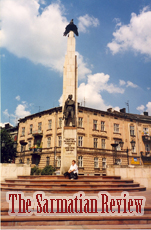| This Issue | Back Issues | Editorial Board | Contact Information |

Travel Notes
Patricia A. Gajda
By Stefan Nesterowicz. Translated from Polish by Elžbieta Szczepaniak McNeilly, edited by Teana Sechelski and Virginia Felchak Hill. Houston: Polish Genealogical Society of Texas, www.pgst.org, 2007). xxii + 150 pages. ISBN 978-0-9798204-1-0. Paper. $23.95 including postage.
Stefan and Melanja Nesterowicz, an educated and accomplished couple, left their Polish home for Brazil, where they lived for some years among other Polish immigrants before moving to the United States and accepting employment at a Polish-language newspaper, Echoes of America, in Toledo, Ohio. It was for this paper that Stefan undertook an arduous journey in 1909 to visit and write about the Poles who had immigrated to the rural American South, their role in society, their travails and successes, and their devotion to the Catholic Church. These articles were later compiled into a book, Notatki z podróžy (Toledo: A. A. Paryski, 1910). An English translation was published in 1969. When both of these were out of print and no longer available, the Polish Genealogical Society of Texas undertook the current project and sponsored a new translation. Remaining faithful to the original manuscript, the new PGST volume includes only those photographs that appeared in the original Polish edition. Some of them were enhanced with current technology, and provide corrections of names and other data confirmed by recent research in documentary sources, but set off in brackets to distinguish them from the original text.
Nesterowicz briefly takes the reader to Polish settlements in Arkansas, Louisiana, and Mississippi, but devotes fully two-thirds of the book to those in Texas. His focus is on the immigrant families (some of whom were subscribers of his newspaper), their expressions of Polish cultural identity, and their social and economic contributions to their communities. In this, he followed another traveler, Frederick Law Olmsted, who likewise described Texas through which he traveled. Long before he became the great planner and landscape architect, Olmsted traveled through the south, particularly Texas, in the 1850s and indulged what biographer Witold Rybczyński (A Clearing in the Distance, Scribners, 1999) described as his “passion” for detailed observation. Olmsted recorded his visits, viewed through the lens of antislavery, with brilliant descriptions of the land and the people, and remarkable insights into the social-economic realm. Nesterowicz, too, reliably describes the land, its cost, farm methods and crops, as well as the income they provide. Like Olmsted, he is acutely aware of the geographic context within which people live, sensitive to the many injustices they face, and admiring of their many virtues.
The lens through which he writes is one of sympathy and generosity of spirit. He reports facts, but he also examines relationships among the various ethnic groups, often observing the demeaning manner “Americans” use when dealing with “blacks.” Even he, however, unconsciously assumes prevailing stereotypes of happy dancing folk and undependable workers who spend all their money as soon as it is earned, unlike the hard-working and thrifty Poles. He is always focused on the Polish immigrants; the partition of the former Poland from which they came; and the relationships they maintained not only among themselves but also with their neighbors, often Germans, Jews, Czechs, Italians, or Moravians. In one long commentary, he dwells on the sometimes unhappy relationship between “Poles” and “Jews” following the time of the “kind-hearted” King Kazimierz the Great, a passage interesting as a measure of the sympathetic attitude toward Jews he articulated in the first decade of the twentieth century.
Nesterowicz’s writing style is more spare than elegant, but it shines with an intelligence, honesty, and insight that make his observations a valuable record for scholars of history and the social sciences, genealogists, and readers interested in learning about immigrant rural communities as they were a century ago at the height of immigration to America from central and eastern Europe.
Nesterowicz demonstrates a good understanding of many facets of agriculture, social relations, and the economy, but especially of Polish identity. Many times he equates the depth of a person’s sense of that identity with the “purity” of Polish spoken. He observes that although they integrated well with other Americans and learned English, Poles in the rural south retained the purity of their mother tongue and knowledge of their national history and literature better than those who settled in urban communities, especially in the North, where Poles tended to pepper their language with ever-increasing numbers of English words. He notes the attempts made in places such as Houston to preserve the Polish language and provide English translations of Polish literature. He meticulously lists names of Catholic parishes and priests who served in the communities where the Poles lived, sometimes Poles who had been brought from Europe, other times priests who either learned some Polish in the course of their ministry or provided parish schools with Polish-speaking, teaching nuns.
At first this book appears to consist of simply expressed, factual observations, barely vignettes, one after another in a long string, organized conveniently by town or settlement that made up Nesterowicz’s itinerary. Before long, however, other facets of the book become apparent. A moment in the life of each settlement, frozen in time, becomes part of a larger portrait. The vignettes of Polish founders of these communities, statistics showing the prosperity of many Poles not only in agriculture but also in commerce, and the history of Polish Catholic churches and schools unfold with great clarity. Sometimes Nesterowicz himself becomes a character, as he complains about the inadequate train service and the discomfort of his journey on bad roads. Finally, what shines through is the author‘s concern for justice, his appreciation of people of all strata of society, and his charm.
.Back to the January 2009 Issue
The Sarmatian Review
sarmatia@rice.edu
Last updated 2/21/09